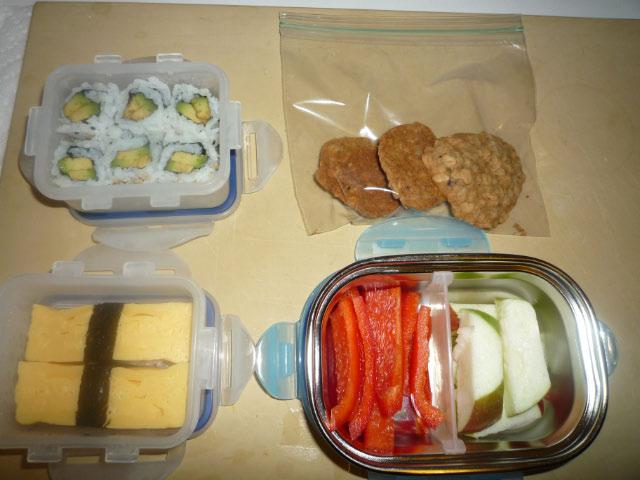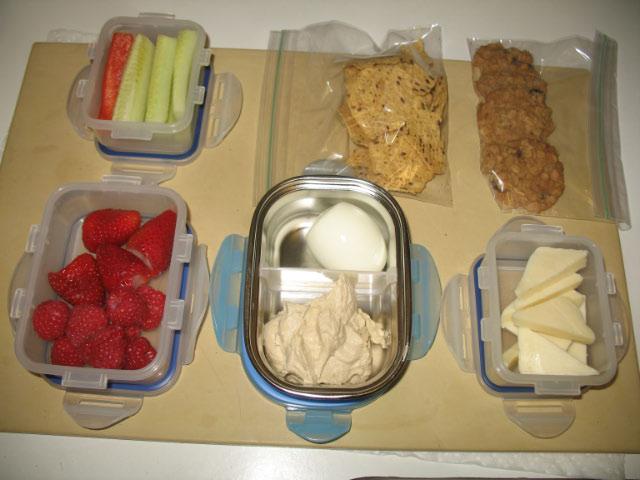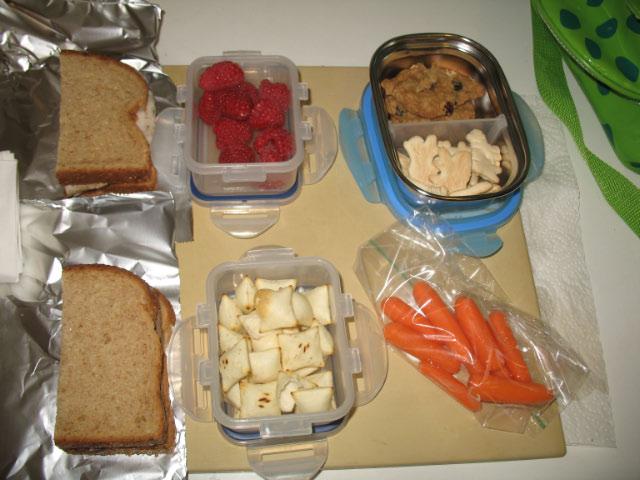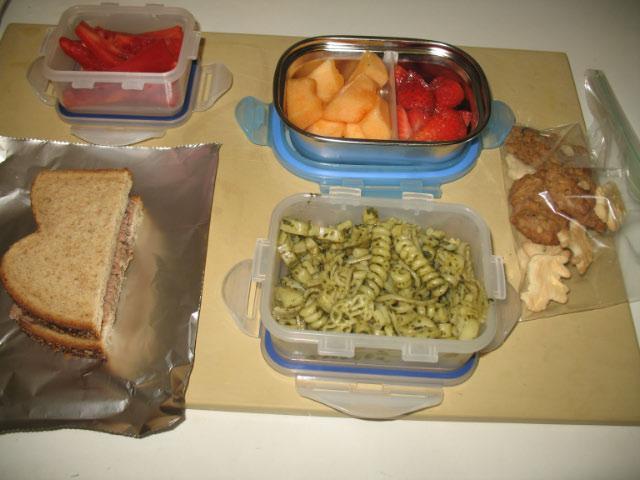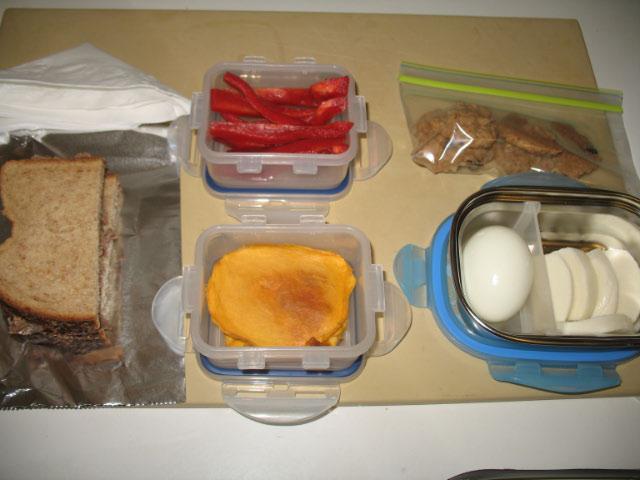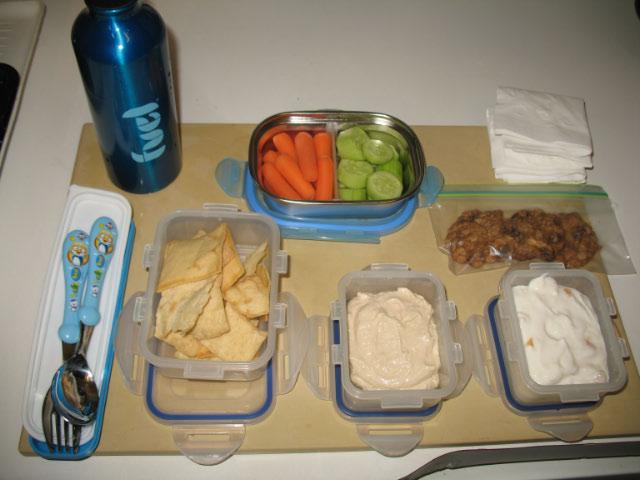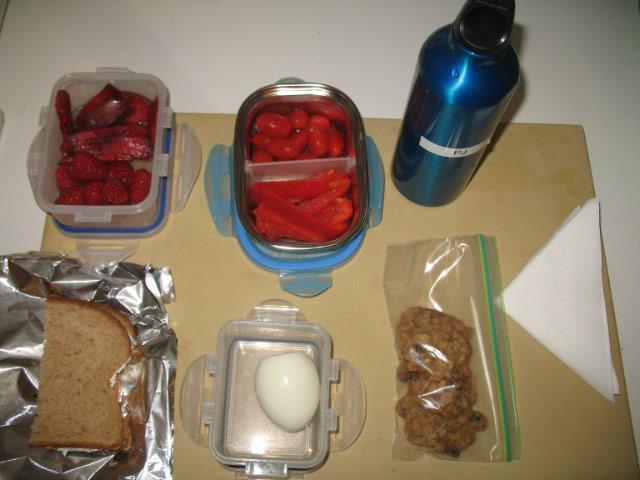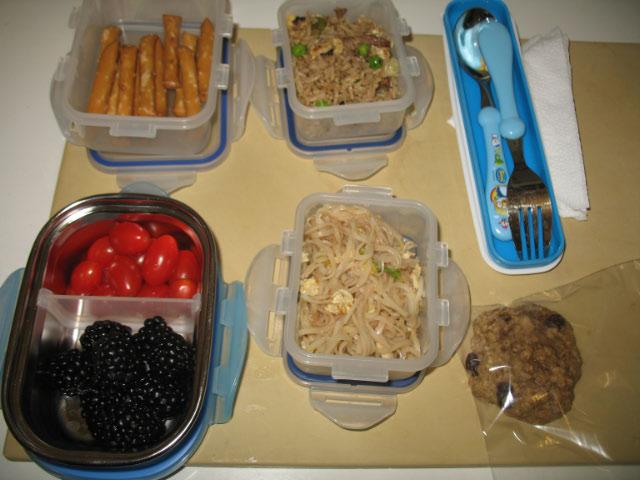-
Posts
28,458 -
Joined
-
Last visited
Content Type
Profiles
Forums
Store
Help Articles
Everything posted by Fat Guy
-
For the purpose described, I'm not sure there's anything better than Forschner or one of the other economical foodservice brand knives. The next logical step up, one of the more economical Japanese-knife brands, seems like a bit much for the circumstances.
-
The latest ruling from on high at the school is that we're supposed to strive for "waste-free lunches." In other words no zipper bags or other disposable packaging. I took a crack at it this morning but realized I will need more (and mostly smaller) containers to pull that off consistently. I also noticed that Amazon has those little plastic soy-sauce bottles cheap, so I ordered some.
-
I don't necessarily think in the final analysis one is "faster" than the other. In the preparation of most dishes, you have your prep time, your active cooking time, and your unattended cooking time. The task of making high-quality meals quickly involves the timing and interplay of those three variables. It doesn't necessarily mean you have to get each as close to zero as possible. You're just trying to move them outside of the time frame in which you don't want to experience any waiting. It's just like with long-rise bread: yes it has to rise for 18+ hours, but if you organize yourself around that schedule the actual time commitment by you is close to zero. So something that takes more time can actually take less time. One area in which I think it's worth doing a little more thinking is the area of par-cooking,. Restaurants do a lot of this and, I think, the competent ones get some respectable results. Restaurant risotto, for example, is most always picked up from par-cooked rice. Most any time you have potatoes in a restaurant they have been in some way cooked first, then finished to order. It's standard procedure in several places -- some critically acclaimed -- to sear off the protein, refrigerate and finish to order in a convection oven. It probably goes without saying that raw foods -- cheese, charcuterie, etc. -- don't require any cooking time.
-
Already mentioned once but let me reiterate that making a salad mix in bulk on Sunday can give you salads through Wednesday or Thursday. So for example you might wash and dry red-leaf lettuce, arugula, radicchio and endive and refrigerate a ton of that mix. Then on the day of service you slice tomato and cucumber and you have a salad. Needless to say, your mustard vinaigrette is already prepared in bulk in the fridge. There has already been so much good advice here, I think it illustrates that making 30-minute meals is totally doable. I do think there are some strategy notes I can offer, though. My time constraints come from needing to get dinner on the table early, because we have a five-year-old to get fed, bathed and into bed. So even though I work, such as it is, at home I try to compress the dinner timeline so I can have a full day. For example, I find it very helpful to examine the week as a whole and implement some rituals. Although we don't have Prince spaghetti night, in a week where I prepare dinner five nights (that doesn't happen every week, but does happen sometimes) there is always one night we do takeout and one night we do mixed-bag leftovers -- usually Thursday and Friday respectively. Having those anchors means there are only three nights left on which real meals need to be prepared. One of those nights being Monday, it's possible to do most of that prep on Sunday. Then for the Tuesday and Wednesday meals you rely on things like the frozen meatballs, chili and lentil soup. The breakfast-for-dinner ritual is good for a night if you want it. If your family is into rituals, you can even make a schedule. Another thing I find is that, even when people are pretty clever about preparing good food quickly, they tend to prepare only one thing. I think the real badass display of cooking prowess is to do the meal quickly and also serve a lot of different things. Always including a salad, which can be served as a separate course, can really enhance the meal. So can putting out the kind of stuff you'd put out for guests: olives, nuts, pita chips and hummus, whatever -- I mean just put that stuff out in addition to the meal you're serving, in order to create a sense of diversity and abundance. Then there's the question of what's on your route home. Like, if I'm going to be coming home on the subway, I know I can go by Le Pain Quotidien for a great loaf of bread and that the time expenditure will be on the order of a minute. If it happens to be a night when my wife isn't in the picture, my son and I love to make a meal of bread with an array of stuff to put on it (cheese, butter, jam, etc.) Also, I suggest giving some thought to containers. We use a lot of Pyrex because it can go from fridge to microwave to table. You don't have to deal with transferring stuff. And if you're using glass lids, you can often microwave with the lid on to avoid mess and improve heat retention and distribution. (The trick with something like chili is to overheat a little and then let it rest so the heat evens out.) That way you can walk in the house and just put the Pyrex in the microwave, punch in the time, then worry about your coat and such. You can also delegate that job to a non-cook if someone else gets home before you. Finally, has anyone mentioned the broiler? I think the broiler has got to be the most underutilized tool in the typical American kitchen. Bear in mind, in particular, that most fish fillets can be cooked very quickly under the broiler.
-
Welcome to Bouche, the official news-and-updates topic for the eGullet Society. We'll be using this topic to keep our members, readers and fellow travelers posted on the latest and greatest from the four corners of our webspace and beyond.
-
Here it is: The container has served us well. It operates smoothly, just like the Lock & Lock products, and makes a tight seal. I should add, though, that two of the other containers I purchased at H-Mart are still -- more than a year later -- too tight for PJ to open.
-
Somewhere way back on the topic you can see a photo of the lid for that container. It shows some Korean cartoon penguin named Pororo. The fork-and-spoon set has the same character on it. I got both items at H-Mart, the Korean-American megastore chain.
-
This past weekend I did some reconnaissance on available containers in Northern New Jersey but, thanks to traffic, didn't get to close the deal. I'm hoping to upgrade my collection soon, though. The real bummer is that they had a great sale on Lock & Lock containers at a store in Teaneck called Amazing Savings, but they only had larger sizes -- for a dollar. The whole process of making lunches has been enlightening for me, in large part because it's a study in working against inertia. While it's theoretically possible to come up with amazing lunches, several realities work against. First, there are some issues I think are probably universal: - A lot of kids (mine included) favor repetition of items over trying new items. All the creative meal ideas in the world don't mean anything if your kid doesn't actually eat the lunch you pack. - It's challenging to shop in such a way as to provide diversity without being wasteful. The small quantities involved mean that even a small batch of something provides enough product to make five days worth of lunches. - Unless you want to get up at 4am (and I say this fully aware that is is at the moment 4am) every day, you either have to abbreviate the project time or you have to make lunch the night before. Both approaches present limitations. And then there are some problems we have here in the US that don't seem to exist in Japan. I'm not sure where other countries come out on all this: - The procedures for storing lunches in most US schools are not conducive to packing anything that needs to stay flat. - The available inventory of containers in the West is much more limited than in the East. It's possible to acquire a good range of items but it's a project to do so. - Allergy policies, now the norm in US schools, limit the available palette of ingredients. - The impoverished US school-lunch scene means your kid is the outlier if he or she has a non-crappy lunch, or anything that smells, etc. I also keep thinking about definitions of "bento" and whether anything I make for lunch approaches any conceivable definition of the term. Certainly there is a narrow, traditional definition out there that excludes not only my son's lunches but also many of the lunches that have been posted on this topic. I guess the broader definition is "any portable lunch where some care in packaging and presentation has been taken." I don't know. Anyway . . . let me catch up on recent lunches. At some point I have really got to up my game in terms of my own sushi making, so I don't have to rely so heavily on restaurants. At the moment I live across the street from a place that makes decent sushi cheap, but eventually I won't. At this point I can make rudimentary maki but not well enough to create a consistently attractive result that holds together well for travel. (No I did not make the sushi items pictured here.) I recently started experimenting with adding meat items to PJ's lunches (as you may recall last year's school had a no-meat policy). In our first discussion of the possibilities he asked me to make a brisket. This created two issues: First, a brisket of beef, even in its smallest subdivided supermarket incarnation, is a fairly large piece of meat that generates enough product for about 25 school lunches. Second, it's hard to think of a way to package it that isn't a sandwich. I was also not completely convinced that he'd enjoy cold brisket, so for our first brisket outing I made half a brisket sandwich and half a turkey sandwich. He ate the brisket with gusto and rejected the turkey, and asked for brisket in his next two lunches (until the week thankfully ended). (In the above photo there's also a pasta salad made with pesto and a medley of pasta shapes utilizing excess from the previous night's dinner.) The profusion of brisket with which I was faced could have provided lunches for a month, but I eventually made chili with the remaining meat and took brisket out of the rotation. I'll do another round of brisket at some point, though. Yesterday I utilized leftovers from some noodles (bun xao) and fried rice (com chien) from our local Vietnamese place. PJ was a fan of the fried rice consumed at room temperature. The noodles didn't work for him, though. I think I'm now all caught up. Time to figure out today's lunch.
-
The meat of short ribs is tough and full of collagen, so it's not very appetizing unless it's cooked in such a way as to tenderize it. There are two main ways to do this, as well as a few minor variations. The most common way to prepare short ribs in Western cookery is by braising them. That can be done in stock, wine, beer, etc. The other thing I see done a lot is the Korean barbecue approach: thin slicing and marinating, followed by cooking on a hot grill or griddle.
-
Isn't that just the taste of celery? What does it taste like minus that taste?
-
From the perspective of energy efficiency, you'd always want to blend with the blender and heat with a stove or other dedicated heating appliance. But there are other measures of efficiency, like number of utensils to clean and number of steps in the cooking process, that argue for using a little more time and energy to heat something in the blender so you don't have to transfer it to a pot, heat it up on the stove, and clean the pot. I will say that, while the tiny physicist inside me recoils at the notion of heating with a blender (unless it's a Thermomix), the practical cook likes being able to put in all the ingredients for soup (or fondue), push a button and be done with it.
-
I'm in the early stages of planning year 3 of this undertaking. It happens in February. One thing I'm going to try to do this time around is get a second set of hands working with me. Better glassware. Actual fresh citrus. We'll see if I can pull off something respectable here.
-

Help with a lack of inspiration in the kitchen
Fat Guy replied to a topic in Food Traditions & Culture
Whenever that happens, it seems to be because I have temporary amnesia about what I'm capable of making. I always think, okay, what I need to do is keep a list of dishes I've made that I thought were really good, so I can consult that list when I need inspiration. Then I forget to make the list. So I cook some eggs. -
I'm also interested to know how much influence Sifton's discussions with Ladner (and presumably Batali) had on his decision to award four stars. Was there a lobbying effort and did it matter?
-
I think if you say the benchmark for four stars is Per Se then there have only been two four-star restaurants in the past decade: Per Se and Alain Ducasse at the Essex House. If you say there's a range within the four-star world, with Daniel and Eleven Madison at the lower end of that range, then it opens up the field and you have to start asking questions like "Isn't Kreuther's food better? Isn't Liebrandt's food more interesting -- and better? Isn't Blue Hill at Stone Barns a better experience?"
-
That I think is the core issue facing the reviewer: The four-star framework, like the Michelin three-star framework, has in recent history as a structural matter favored French restaurants. It's a common complaint in Italy that the restaurants with three Michelin stars are too Frenchified to be considered Italian anymore. So it may be that Lupa is a better Italian restaurant than Del Posto but Lupa can never get four stars and Del Posto can.
-
I think Alto was also conceived as a four-star Italian restaurant. There are some other restaurants that today are probably feeling left out: The Modern, Corton, Marea (as mentioned)... Personally I think the restaurant that really deserves four stars is Blue Hill at Stone Barns. I believe it provides one of the very best dining experiences in the world, at least based on where I've eaten. I also think it's a shame that Cru was never recognized, in its heyday, as one of the very best restaurants in New York. I thought Sifton's comment about intent was interesting, if only because I'm not sure any critic has said it so forthrightly: "The distance between three and four stars is at once huge and infinitesimal. It goes to both intent and execution." (From the Diner's Journal piece.)
-
Color me surprised. But I must agree with sethd: on its own terms, the review is compelling -- and the argument is even stronger when you look at the accompanying Diner's Journal material, where he details his perception of the restaurant's evolution and embeds some interesting collateral video content. One thing I think is worth clarifying. In describing Del Posto's improvement, Sifton says, among other things, "Mr. Ladner hired a new pastry chef, Brooks Headley." This to me implies the restaurant dismissed a failing pastry chef and added a successful one. Just in case anybody else read it that way, it should be pointed out that when Headley was hired Del Posto had no pastry chef. I believe Nicole Kaplan, the previous pastry chef, left the restaurant to work at the Plaza. The restaurant was then without a pastry chef for several months, and finally hired Headley. There is little question that both are exceptionally fine pastry chefs. Mark, in terms of the total number of four-star restaurants, you're undoubtedly correct in terms of recent history. I have no idea what was going on in the 1970s, though. I get the sense there were a lot of places back then that got four stars.
-

Less than a Quarter of Meals include Vegetables
Fat Guy replied to a topic in Food Traditions & Culture
We get our largest hit of vegetables in the form of salad. Nearly every dinner we prepare at home includes a green salad with mixed vegetables: lettuce, tomato and cucumber at a minimum, and usually also arugula, colored bell peppers, sprouts, beets, shredded carrots and other stuff. We tend to make big ones, so if the CDC are measuring by the serving we must be getting four or five a day just from that. And salad can be ridiculously easy. Supermarkets, at least in the US, sell triple-washed, ready-to-go greens in bags and clamshell packs. There are a lot of choices, including mixes with herbs. You just put a few fistfuls of these greens in a bowl and you're 80% of the way to a salad. A lot of other stuff can be had in forms that don't even require a knife, such as little cherry or grape tomatoes, pre-shredded carrots and sprouts of all kinds. -

Kitchen gadgets for those with injuries & disabilities
Fat Guy replied to a topic in Kitchen Consumer
A good way to keep a cutting board from slipping is to put a damp towel (cloth or paper) underneath it. That's a standard restaurant-kitchen trick. Those curved knives are great for one-handed use. Also the jar and can openers, and peppermills/grinders. I don't know how it is in Japan, and this isn't so much a gadget as a retail reality, but here in the US there's a lot of availability of prepped (peeled, chopped, sliced, diced, etc.) vegetables in supermarkets. I relied heavily on that stuff, which I formerly ridiculed, when I tore my rotator cuff a while back. (I still have pain, and now even with full use of my arm there are many kitchen tasks where I have to ask myself if it's worth the pain or if I should find a different way to do it.) -

Less than a Quarter of Meals include Vegetables
Fat Guy replied to a topic in Food Traditions & Culture
P.S. I think this is the actual CDC statement. It doesn't shed any light on the language question. -

Less than a Quarter of Meals include Vegetables
Fat Guy replied to a topic in Food Traditions & Culture
The only way that would make sense would be if three times means three servings as opposed to vegetables at three separate sittings. -

Less than a Quarter of Meals include Vegetables
Fat Guy replied to a topic in Food Traditions & Culture
The American supermarket overflows with vegetables that require no prep work and in many cases no cooking. Triple-washed salad greens (and spinach) in plastic clam-shell packaging is something you see in most places now. Pre-cut, or "baby," carrots are universal -- sometimes they even come in little packages with a dip or the like. Cherry or grape tomatoes. Pre-sliced mushrooms. I often see pre-cut "stir-fry vegetables" and such on offer. If people aren't eating vegetables it's not because of inconvenience. -

Kitchen gadgets for those with injuries & disabilities
Fat Guy replied to a topic in Kitchen Consumer
Have you seen the Dynamic Living website? In particular, the kitchen section has several gadgets designed for one-handed use. -
Percival: if you count breakfast sandwiches, burgers and hot dogs, I know plenty of people who are 2-sandwich-a-day consumers. At least according to this source, the hot dog number alone is 20 billion (variants of this number are repeated all over the internet; I'm not sure of its actual veracity, though), leading me to think that maybe the people who came up with the 45 billion number weren't even going down the hot-dog path. I don't know. Certainly you have some people in the population eating zero sandwiches. But there could easily be just as many doing 10 a week. Nakji: I think the American sandwich culture is part adopted and part original. Banh mi would be a clear case of adoption. The Reuben is a clear case of an American original. Then there are gray areas, such as the hamburger and the hot dog. Some would argue that these have foreign roots, but they have been so thoroughly integrated into and built upon by Americans that all the world acknowledges them as American. But the reason I said "limited if not impoverished" was because those have been the two options I've seen: 1- limited, or 2- impoverished. So, for example, Vietnam has banh mi. That's a great sandwich. But does Vietnamese sandwich culture go much deeper than that? I think it's fair to say that Vietnamese sandwich culture is limited compared to the incredible diversity of American sandwich culture. And I think there are plenty of countries where the sandwich culture is downright impoverished.


